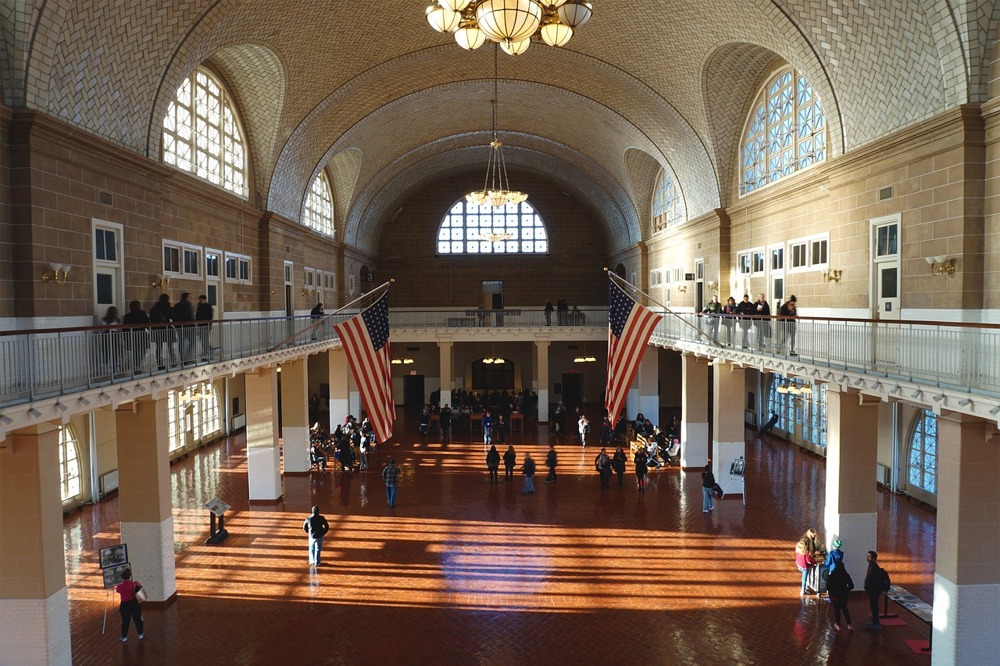Great Hall
Ellis Island
Home > New York State Photographs > New York > Great Hall, Ellis Island

The Great Hall on Ellis Island was alive with the conversations of visitors from all walks of life, some here to learn more about their own family history, and others to understand the great narrative of immigration to the United States. The vastness of the room and the number of stories it contained was a humbling reminder of the journeys of millions of immigrants who had stepped foot on these shores in search of a better life.
The air inside the hall was thick with memories of the past; whispers of languages both forgotten and still spoken echoed off the walls. There was a reverence for the stories of those who had come before, and what their incredible courage and resilience meant to this country. Even the silent artifacts on display spoke volumes, telling stories of endurance, hope, and perseverance.
Everywhere you looked, there was something new to explore - a photograph, a piece of furniture, a piece of clothing, a piece of music. All these pieces together formed the story of Ellis Island, and the story of the immigrant experience in the United States. There was a sense of pride and accomplishment in knowing that even though the journey of immigrants could sometimes be difficult, it was ultimately a journey worth taking.
Ellis Island
Ellis Island is a small island located in the upper New York Bay, near the entrance to the Hudson River in the United States. It holds significant historical and cultural importance as the site of the largest immigrant processing station in the United States during the late 19th and early 20th centuries. Ellis Island operated as an immigration station from 1892 to 1954 and played a crucial role in the history of American immigration.
Here are some key points about Ellis Island:
Immigration Hub
Ellis Island served as the primary immigration processing station for millions of immigrants coming to the United States between 1892 and 1954. During this period, it processed over 12 million immigrants, most of whom arrived from Europe, seeking a new life and better opportunities in America.
Arrival and Processing
Immigrants arriving in New York Harbor by ship would first catch sight of the Statue of Liberty and then disembark on Ellis Island. Here, they underwent a series of inspections and examinations to determine their eligibility to enter the United States. This included medical examinations to check for contagious diseases and a legal inspection to ensure they met the entry requirements.
Processing Facilities
The island's facilities included medical buildings, dormitories, and administrative offices. Immigrants were subjected to various health checks, and those found with contagious diseases or other serious medical conditions were quarantined or, in some cases, sent back to their home countries. The processing could be a daunting experience for many immigrants, as they could be denied entry.
Immigrant Stories
Ellis Island holds a special place in the collective memory of immigrants and their descendants. For many, it represents the gateway to a new life in America, full of hope and opportunity. The American Immigrant Wall of Honor on the island is a tribute to the immigrants who passed through and their contributions to American society.
Closure and Restoration
Ellis Island ceased processing immigrants in 1954 due to changes in immigration laws and procedures. The island was abandoned and fell into disrepair for several years. However, it was later restored and reopened as a museum and National Park in 1990. Today, visitors can explore the museum to learn about the immigrant experience and trace their family roots through genealogical research.
Symbol of Immigration
Ellis Island has become a symbol of American immigration and a testament to the diverse and multicultural nature of the United States. It is a popular destination for tourists and a place where many Americans can trace their family history back to their immigrant ancestors.
In summary, Ellis Island played a pivotal role in the history of American immigration, serving as the first point of entry for millions of newcomers to the United States. It stands as a symbol of hope and opportunity for those who came seeking a better life in America and is an important historical and cultural landmark in the country.


